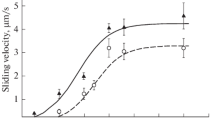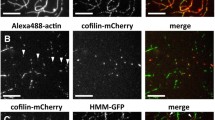Summary
Monoclonal antibodies binding to epitopes in the rod portion of brush border myosin were used to study the mechanism of filament assembly and its role in myosin interaction with actin. The antibodies and their Fab fragments had specific effects on the size of the filaments assembledin vitro. Two antibodies (BM3 and BM4), directed against the tip of the myosin tail, completely inhibited myosin filament assembly. The other antibodies (BM1, BM2 and BM5), binding to other sites along the myosin rod, only partially blocked filament growth, and short filaments could be assembled. Thiophosphorylated brush border myosin filaments appeared slightly more stable to the effects of the antibodies than those composed of dephosphorylated myosin. Only one (BM3) of the antibodies which completely inhibited the assembly of new filaments was capable of disassembling preformed myosin filaments. The other antibody, BM4, partially disassembled filaments, leaving ∼0.2-μm long ‘cores’, suggesting that polymerization in this myosin occurs by a biphasic Mechanism, I.e. the formation of a stable nucleus of antiparallely packed molecules, followed by elongation. The antibodies BM1 and BM2 bound to myosin filaments generating a regular transverse pattern with a ∼14-nm periodicity, and had little effect on the stability of these preformed filaments. Inhibition of filament formation and solubilization of the myosin by the antibodies appeared to be associated with inhibition of myosin interaction with actin, as measured by the actin-activated MgATPase activity. In the presence of the antibodies which completely inhibit filament assembly, we observed a decrease to ∼20% (BM4-Fab) and to ∼50% (BM3) of the control actin-activated myosin MgATPase activity, and this activity was kinetically different from that of the soluble myosin S1 fragment, suggesting that the rod has a profound effect on the kinetics of actomyosin interaction.
Similar content being viewed by others
References
Adelstein, R. S. &Eisenberg, E. (1980) Regulation and kinetics of the actin-myosin-ATP interaction.Ann. Rev. Biochem. 49, 921–56.
Barylko, B., Tooth, P. &Kendrick-Jones, J. (1986) Proteolytic fragmentation of brain myosin and localization of the heavy chain phosphorylation site.Eur. J. Biochem. 158, 271–82.
Citi, S. &Kendrick-Jones, J. (1986) Regulationin vitro of brush border myosin by light chain phosphorylation.J. molec. Biol. 188, 369–82.
Citi, S. &Kendrick-Jones, J. (1987) Studies on the structure and conformation of brush border myosin using monoclonal antibodies.Eur. J. Biochem. 165, 315–25.
Citi, S., Smith, R. &Kendrick-Jones, J., (1987) The effects of light chain phosphorylation and skeletal myosin on the stability of nonmuscle myosin filaments.J. molec. Biol. 198, 253–62.
Collins, J. H., Cote, G. P., &Korn, E. D. (1982a) Localization of the three phosphorylation sites on each heavy chain ofAcanthamoeba mysoin II to a segment at the end of the tail.J. biol. Chem. 257, 4529–34.
Collins, J. H., Kuznicki, J., Bowers, B., &Korn, E. D. (1982b) Comparison of the actin binding and filament formation properties of phosphorylated and dephosphorylatedAcanthamoeba myosin-II.Biochemistry 21, 6910–15.
Craig, R. &Megerman, J. (1977) Assembly of smooth muscle myosin into side-polar filaments.J. Cell Biol. 75, 990–8.
Craig, R., Smith, R. &Kendrick-Jones, J. (1983) Light chain phosphorylation controls the conformation of vertebrate non-muscle and smooth muscle myosin molecules.Nature 302, 436–9.
Cross, R. A. &Vandekerckhove, J. (1986) Solubilitydetermining domain of smooth muscle myosin rod.FEBS Lett. 200, 355–60.
Cross, R. A., Cross, K. E. &Sobieszek, A. (1986) ATP linked monomer-polymer equilibrium of smooth muscle myosin: the free folded monomer traps ADP.Pi.EMBO J. 5, 2637–41.
Davis, J. S. (1981) The influence of pressure on the self assembly of the thick filament from the myosin of vertebrate skeletal muscle.Biochem. J. 197, 301–14.
Davis, J. S. (1985) Kinetics and thermodynamics of skeletal myosin: a pressure jump study.Biochemistry 24, 5263–9.
Goding, J. W. (1983) InMonoclonal Antibodies: Principles and Practice, pp 114–24, New York: Academic Press.
Harrington, W. F. &Rodgers, M. E. (1984) Myosin.Annu. Rev. Biochem. 53, 35–73.
Hinssen, H. J., D'Haese, J., Small, J. V. &Sobieszek, A. (1978) Mode of filament assembly of myosin from muscle and nonmuscle cells.J. Ultrastruc. Res. 64, 282–302.
Huxley, H. E. (1963) Electron microscope studies on the structure of natural and synthetic filaments from striated muscle.J. molec. Biol. 7, 281–308.
Huxley, H. E. (1969) The mechanism of muscular contraction.Science 164, 1356–66.
Josephs, R. &Harrington, W. F. (1966) Studies on the formation and physical chemical properties of synthetic filaments.Biochemistry 5, 3474–87
Josephs, R. &Harrington, W. F. (1968) On the stability of myosin filaments.Biochemistry 7, 2834–47.
Kendrick-Jones, J., Lehman, W. &Szent-Gyorgyi, A. G. (1970) Regulation in molluscan muscles.J. molec. Biol. 54, 313–26.
Kendrick-Jones, J., Tooth, P. J., Taylor, K. A. &Scholey, J. M. (1982) Regulation of myosin filament assembly by light chain phosphorylation.Cold Spring Harbour Symp. Quant. Biol. 46, 929–38.
Kendrick-Jones, J., Cande, W. Z., Tooth, P. J., Smith, R. C. &Scholey, J. M. (1983). Studies on the effect of phosphorylation of the 20,000 Mr light chain of vertebrate smooth muscle myosin.J. molec. Biol. 165, 139–62.
Kendrick-Jones, J., Smith, R. C., Craig, R. &Citi, S. (1987) The polymerization of vertebrate nonmuscle and smooth muscle myosins.J. molec. Biol. 198, 241–52.
Kiehart, D. P. &Pollard, T. D. (1984) Polymerization ofAcanthamoeba myosin-II stimulates actomyosin ATPase activity.Nature 308, 864–6.
Kiehart, D. P., Kaiser, D. A. &Pollard, T. D. (1984a) Monoclonal antibodies demonstrate limited structural homology between myosin isozymes fromAcanthamoeba.J. cell Biol. 99, 1002–14.
Kiehart, D. P., Kaiser, D. A. &Pollard, T. D. (1984b) Direct localization of monoclonal antibody-binding sites onAcanthamoeba myosin II and inhibition of filament formation by antibodies that bind to specific sites on the myosin-II tail.J. Cell. Biol. 99, 1015–33.
Kuczmarski, E. R. &Spudich, J. A. (1980) Regulation of myosin self assembly: phosphorylation ofDictyostelium heavy chain inhibits formation of thick filaments.Proc. natn. Acad. Sci. USA 77, 7292–6.
Kuznicki, J., Cote, G. P., Bowers, B. &Korn, E. D. (1985) Filament formation and actin activated ATPase activity are abolished by proteolytic removal of a small peptide from the tip of the tail of the heavy chain ofAcanthamoeba myosin II.J. biol. Chem. 260, 1967–72.
Lowry, O. H., Rosebrough, N. J., Farr, A. L. &Randall, R. J. (1951) Protein measurement with the Folin reagent.J. biol. Chem. 193, 265–75.
Margossian, S. S. &Lowey, S. (1982) Preparation of myosin and its subfragments from rabbit skeletal muscle.Methods Enzymol. 85, 55–71.
Maruta, H. &Korn, E. D. (1979).Acanthamoeba myosin II.J. biol. Chem. 252, 6501–9.
Matsudaira, P. T. &Burgess, D. R. (1978) SDS microslab linear gradient polyacrylamide gel electrophoresis.Analyt. Biochem. 87, 386–96.
Niederman, R. &Peters, L. K. (1982). Native bare zone assemblage nucleates myosin filament assembly.J. molec. Biol. 161, 505–17.
Nyitray, L., Molz, G., Szilagyi, L., Balint, M., Lu, R. C., Wong, A. &Gergely, J. (1983) The proteolytic substructure of light meromyosin: localization of a region responsible for the low ionic strength insolubility of myosin.J. biol. Chem. 258, 13213–20.
Pagh, K. &Gerisch, G. (1986) Monoclonal antibodies binding to the tail ofDictyostelium discoideum myosin: their effects on antiparallel and parallel assembly and actin-activated ATPase activity.J. Cell. Biol. 103, 1527–38.
Perrie, N. T. &Perry, S. V. (1970) An electrophoretic study of the low molecular weight components of myosin.Biochem. J. 119, 31–8.
Pollard, T. D. (1982) Structure and polymerization ofAcanthamoeba myosin II filaments.J. Cell. Biol. 95, 816–25.
Reinach, F. C. &Fischman, D. A. (1985) Recombinant DNA approach for defining the primary structure of monoclonal antibody epitopes. The analysis of a conformation-specific antibody to myosin light chain 2.J. molec. Biol. 181, 411–22.
Rieker, J. P., Swanljung-Collins, H., Montibeller, J. &Collins, J. H. (1987) Brush border myosin heavy chain phosphorylation is regulated by calcium and calmodulin.FEBS Lett 212, 154–8.
Scholey, J. M., Smith, R. C., Drenckhahn, D., Groeschel-Stewart, U. &Kendrick-Jones, J. (1983) Thymus myosin. Isolation and characterization of calf thymus and thymic lymphocytes, and studies of the effect of phosphorylation of its Mr 20,000 light chain.J. biol. Chem. 257, 7737–45.
Sellers, J. R., Eisenberg, E. &Adelstein, R. S. (1982) The binding of smooth muscle HMM to actin in the presence of ATP: the effect of phosphorylation.J. biol. Chem. 257, 13880–3.
Suzuki, H., Onishi, H., Takahashi, K., &Watanabe, S. (1978) Structure and function of chicken gizzard myosin.J. Biochem. 84, 1529–42.
Trinick, J. &Cooper, J. (1980) Sequential disassembly of vertebrate muscle thick filaments.J. molec. Biol. 141, 315–21.
Trotter, J. A., Nixon, C. S. &Johnson, M. A. (1985) The heavy chain of macrophage myosin is phosphorylated at the tip of the tail.J. biol. Chem. 260, 14374–8.
Trybus, K. M. &Lowey, S. (1984) Conformational states of smooth muscle myosin. Effects of light chain phosphorylation and ionic strength.J. biol. Chem. 259, 8564–71.
Trybus, K. M. &Lowey, S. (1987) Subunit exchange between smooth muscle myosin filaments.J. Cell Biol. 105, 3021–30.
Winkelmann, D. S. &Lowey, S. (1986) Probing myosin head structure with monoclonal antibodies.J. molec. Biol. 188, 595–612.
Author information
Authors and Affiliations
Rights and permissions
About this article
Cite this article
Citi, S., Kendrick-Jones, J. Brush border myosin filament assembly and interaction with actin investigated with monoclonal antibodies. J Muscle Res Cell Motil 9, 306–319 (1988). https://doi.org/10.1007/BF01773874
Received:
Revised:
Issue Date:
DOI: https://doi.org/10.1007/BF01773874




